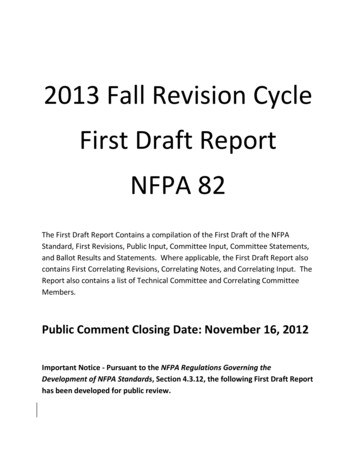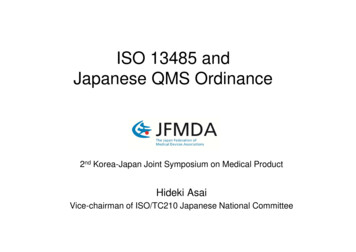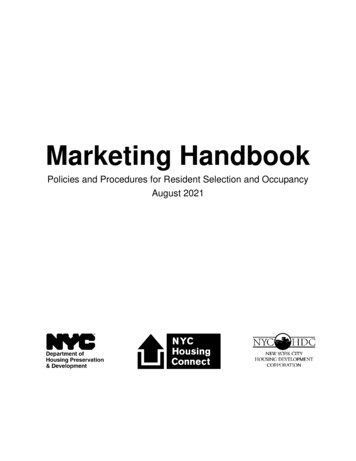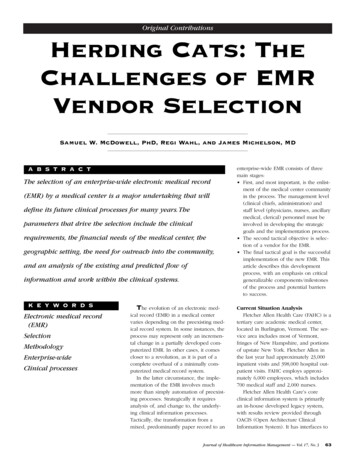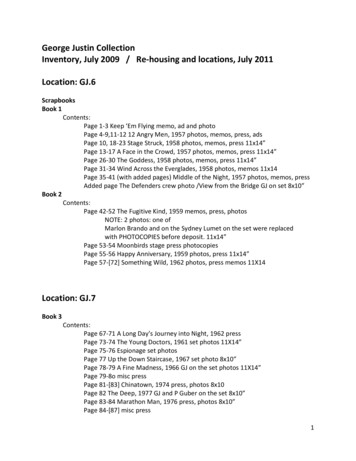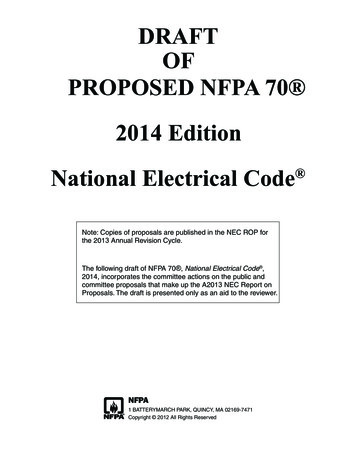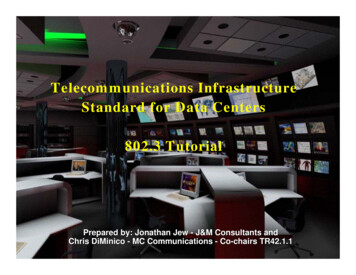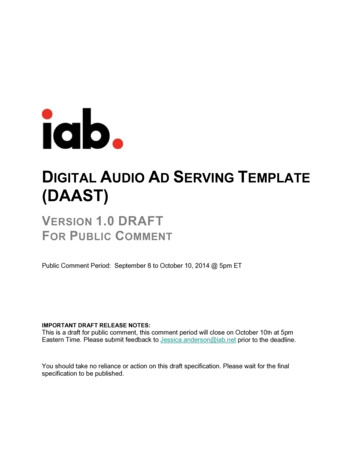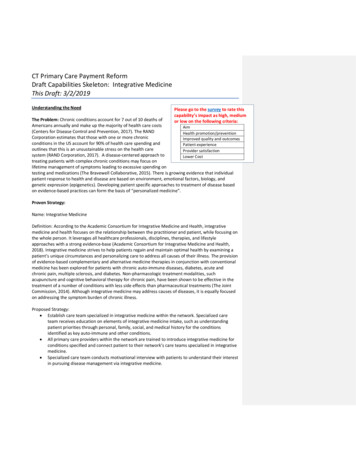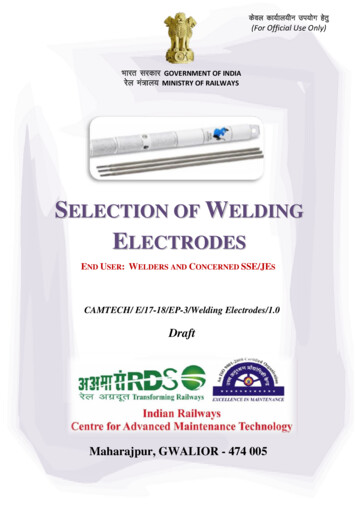
Transcription
dsoy dk;Zky;hu mi;ksx gsrq(For Official Use Only)Hkkjr ljdkj GOVERNMENT OF INDIAjsy ea ky; MINISTRY OF RAILWAYSSELECTION OF WELDINGELECTRODESEND USER: WELDERS AND CONCERNED SSE/JESCAMTECH/ E/17-18/EP-3/Welding Electrodes/1.0DraftMaharajpur, GWALIOR - 474 005
2CAMTECH/E/2017-18/EP-3/Welding Electrodes/1.0SELECTION OF WELDINGELECTRODESQUALITY POLICY“To develop safe, modern and costeffective Railway Technologycomplying with Statutory andRegulatory requirements, throughexcellence in Research, Designs andStandards and Continualimprovements in QualityManagement System to cater togrowing demand of passenger andfreight traffic on the railways”.
CONTENTS1.0INTRODUCTION011.1FACTORS WHILE SELECTING ELECTRODE011.1.1Identify base metals011.1.2Weld Geometry (Joint Fit-up)021.1.3Welding Positions041.1.2Other Factors061.2CLASSIFICATION OF ELECTRODES071.2.1Mild steel electrodes071.2.2Welding Electrode Sizes091.2.3Indian Railways Specifications091.3SUMMARY OF MMAW ELECTRODES101.4CLASSIFICATION OF WELDING ELECTRODES 12(As per IRSM 28-2012)1.5GAS WELDING RODS321.6USAGE AND STORAGE OF ELECTRODES331.6.1Usage and Storage of Electrodes331.6.2Storage of Electrodes341.6.3Drying Electrodes35REMEMBER36IS SPECIFICATIONS37REFERENCES38
CAMTECH/E/2017-18/EP-3/Welding Electrodes/1.01.01INTRODUCTIONWelding is a skill that takes much practice tomaster, and selecting the correct electrode for the jobcan be equally challenging. Electrodes are available in awide range of types, each of which provide differentmechanical properties and operates with a specific typeof welding power source.The selection of a correct type of weldingelectrode for specific application is a very importantconsideration in metal arc welding. Metal weldingelectrodes are used for various applications on theIndian Railway such as in the construction and repairsof rolling stock, structures, bridges, permanent way etc.1.1FACTORS WHILE SELECTING ELECTRODEFactors we should consider when selecting anelectrode include base metal type, joint fit-up andwelding positions.1.1.1 Identify base metalsThe first step in choosing an electrode is todetermine our base metal composition. Our goal is tomatch (or closely match) the electrode composition tothe base metal type, which will help to ensure a strongweld.If we are in doubt about the composition of basemetal, ask our self following questions:Handbook on Selection of Welding ElectrodesDraft
2Q.CAMTECH/E/2017-18/EP-3/Welding Electrodes/1.0What does the metal look like?If we are working with a broken part or component,check for a coarse and grainy internal surface, whichusually means the base material is a cast metal.Q.Is the metal magnetic?If the base metal is magnetic, chances are good that thebase metal is carbon steel or alloy steel. If the basemetal is not magnetic, the material could be manganesesteel, 300 series austenitic stainless steel or a nonferrous alloy such as aluminium, brass, copper ortitanium.Q.What kind of sparks does the metal give off whentouched by a grinder?As a rule of thumb, more flare in the sparks indicates ahigher carbon.Q.Does a chisel “bite” into the base metal or bounce off?A chisel will bite into a softer metal, such as mild steelor aluminium, and bounce off of harder metals, such ashigh carbon steel, chrome-moly or cast iron.1.1.2 Weld Geometry (Joint Fit-up)It is a joint configuration. It tells how two ormore pieces of metal/component can be weld together.Five types of joints have been referred by theAmerican Welding Society: butt, corner, edge, lap, andtee.DraftHandbook on Selection of Welding Electrodes
CAMTECH/E/2017-18/EP-3/Welding Electrodes/1.0(i)3Butt jointA joint between twomembersalignedapproximately in the sameplane (face to face)(ii)T- joint (fillet joint)A joint between twomemberslocatedapproximately at rightangles to each otherin the form of a T.(iii)Corner jointA joint between twomembers located at rightangles to each other at theedge of components.(iv)Lap JointA joint between twooverlapping members.(v)Edge jointA joint between theedges of two or moreparallel or nearlyparallel members.Handbook on Selection of Welding ElectrodesDraft
4CAMTECH/E/2017-18/EP-3/Welding Electrodes/1.0Application of Various Weld JointsAlmost all types of weld configuration are beingused in IR for fabrication of components. Under frame - fillet, butt, corner Coach steel superstructure - butt, fillet, corner Wagon - fillet, butt, corner Steel bridges - fillet, butt, corner, lap1.1.3 Welding PositionsThe American Welding Society (AWS) hasdefined the four basic welding positions.(i)Flat positionIn a flat position, a weld is performed alonglargely a horizontal axis and from above thejoint. It is the easiest type of weld to performand to gain control over the weld pool and achievethe best weld quality.However the same position is some time calleddown hand welding.DraftHandbook on Selection of Welding Electrodes
CAMTECH/E/2017-18/EP-3/Welding Electrodes/1.0(ii)5Horizontal PositionIn the horizontal position, the weld axis is in thehorizontal plane. Horizontal welding is oftenused for fillet or groove welds.(iii)Vertical PositionWith a vertical position, the weld axis is largelyin a vertical or upright position. It is typicallymore complicated to perform than flat andhorizontal. When welding is done on a verticalsurface, the molten metal has a tendency to rundownward and pile up.Handbook on Selection of Welding ElectrodesDraft
6CAMTECH/E/2017-18/EP-3/Welding Electrodes/1.0(iv)Overhead PositionIn this the most complicated of the four, thewelding is performed from the underside of thejoint. In this the metal deposited tends to drop orsag on the plate, causing the bead to have a highcrown.1.1.2 Other FactorsDraftoTensile strength of the required weld.oBase metal composition.oElectrode diameteroThe rate of deposit the weld metal.oThe type of current used.oPenetration required.oMetal thickness.oThe experience of the welder.oThe specifications and service Condition.Handbook on Selection of Welding Electrodes
CAMTECH/E/2017-18/EP-3/Welding Electrodes/1.01.27CLASSIFICATION OF ELECTRODESElectrode:a coated metal wire havingapproximately the same composition as the base metal.Electrodes are mainly classified into 5 main groups:1)Mild steel - majority of welding2)High carbon steel3)Special alloy steel4)Cast iron5)Non ferrous - example Aluminum, Copper, &BrassStandards are set by AWS (American WeldingSociety), ASTM (American Society for TestingMaterials) & BIS ( Bureau of Indian standards).1.2.1 Mild steel electrodesThere are basically two kinds of mild steel electrodes:(i)Bare:Bare electrodes are still covered with littlecovering, this limits their use in the weldingfield.(ii)Shielded (flux coated)Shielded electrodes have a heavy coating on theoutside of them (called flux).Handbook on Selection of Welding ElectrodesDraft
8CAMTECH/E/2017-18/EP-3/Welding Electrodes/1.0Purpose of flux: It prevents corrosion from taking place. It acts as a cleaner and deoxidizes. It releases an inert gas to protect from oxygen,nitrogen, & hydrogen in the atmosphere. Theseelements will weaken the weld if they were tocome in contact with the molten metal. It forms slag to protect the cooling metal & allowsmetal to cool at a slower rate protecting the metalproperties. It provides easier starting arc, stabilizer, reducesplatter. It permits better penetration & X-ray quality. As the electrode burns the flux produces a gaseousshield around the weld. This prevents harmfulcontaminants from hurting the weld. The main 3harmful elements present in the atmosphereo Hydrogeno Oxygeno NitrogenDraftHandbook on Selection of Welding Electrodes
CAMTECH/E/2017-18/EP-3/Welding Electrodes/1.091.2.2 Welding Electrode SizesThe electrode size refers to the diameter of itscore wire. Each electrode has a certain current range.The welding current increases with the electrode size(diameter).Electrode sizeElectrode 10.0mmStandard length of electrodesThe electrodes are generally manufactured in the lengthof 250mm to 450mm.1.2.3 Indian Railways SpecificationsIRSM:28-2012The Indian Railways has issued standard specificationIRSM 28-2012 for manual metal arc welding electrodesand gas welding rods.IRSM:46-2012This specification has been framed for use of MIG(Metal Inert Gas) /MAG (Metal Active Gas) filler wireand classified into various classes as per therequirement of material to be welded.Handbook on Selection of Welding ElectrodesDraft
10CAMTECH/E/2017-18/EP-3/Welding Electrodes/1.0IRSM:39-2001This specification has been framed for use of SAW(Submerged Arc Welding) consumables and classified intovarious classes as per the requirement of material to bewelded.1.3SUMMARY OF MMAW ELECTRODESThe summary of use of manual metal arc weldingelectrodes as per parent material and use as per IRSM28-2012 is given below:Parent MaterialUseClass ofelectrodeLow tensile steelStaticA1-do-Moderate DynamicA2-do-Highly Dynamic/low temperatureA3, A4Pipe weldingAll applicationA5Medium Tensile steel All standardapplicationB1, B2-do-B3, B4Low temperatureapplication below–200CHigh Tensile steelDraftAll applicationC1, C2Handbook on Selection of Welding Electrodes
CAMTECH/E/2017-18/EP-3/Welding Electrodes/1.0Parent MaterialUse11Class ofelectrodeCorten to IRS M-41& IRS M-42All applicationDLow & mediumtensile steelLow heat inputweldingE1 & E2Cast ironsFor reclamation &repairF&GFerrous componentsHard facing offerrous componentsH seriesNon ferrous metal &alloys (Cu & Al)All applicationK&LStainless Steels ofvarious gradesAll applicationM seriesAll ferrous & nonferrous metal &alloysFor cutting &gougingN1, N2 &N3Handbook on Selection of Welding ElectrodesDraft
121.4CAMTECH/E/2017-18/EP-3/Welding Electrodes/1.0CLASSIFICATION OF WELDING ELECTRODES(As per IRSM 28-2012)The electrodes have been classified into 34different classes i.e. A1, A2, A3, A4,A5, B1, B2, B3,B4, C1, C2, D, E1, E2, F, G, H3, H3A, H3B, H3C,H4A, H4B, K, L, M1, M2, M3, M4, M5, M6,M7, N1,N2 & N3.The purpose for which each class of electrode isto be used, together with the IS/AWS code and type ofcoating, is given here under:Sr.No. 1IRS Class:A-1IS/ AWS Spec. : IS: 814-04IS/ AWS Code :ER 4112 (Medium coated)Purpose/ Use:Fabrication of component meant for static applicationmade of steels to IS: 2062-11, Gr E250 Quality A, IS:1875-04 Class 1 & 1A or equivalent.Suitable for joining steel sheets to IS:513-98, IS: 107994 & Gr. Fe 330 to IS:5986-02 or equivalent and forrepair welding of cast steels to IS: 1030-98 Gr.-200400W.This electrode can also be used for welding wherestrength requirement is not specified.Expert Notes:Not fit for dynamic applications.Dry the electrode at 100-120 degree C for 1 hrs. beforeuse.Recommended current AC/DCDraftHandbook on Selection of Welding Electrodes
CAMTECH/E/2017-18/EP-3/Welding Electrodes/1.013Sr.No. 2IRS Class:A-2IS/ AWS Spec. : IS: 814-04IS/ AWS Code :ER 4211X (Medium coated)Purpose/ Use:Fabrication of component meant for semi-dynamicapplication such as bridges etc., made of steel to IS:2062-11 Gr. E250 Quality BR&B0, IS: 1875-04 ClassI & IA or similar.The weld deposit shall be of radiographic quality.Expert Notes:Fit only for moderate dynamic application.Recommended current AC/DCDry the electrode at 100-120 degree C for 1 hrs. beforeuse.Handbook on Selection of Welding ElectrodesDraft
14CAMTECH/E/2017-18/EP-3/Welding Electrodes/1.0Sr.No. 3IRS Class:A-3IS/ AWS Spec. : IS: 814-04IS/ AWS Code :EB 5326H2X (Heavy coated)Purpose / Use:Fabrication of component meant for highly dynamicapplication made of steels to IS: 2062-11 Gr.E 250 quality Cor for other applications where low temperature impactproperty is required.The weld deposit shall be of radiographic quality.Expert Notes:Fit for highly dynamic application.Sr.No. 4IRS Class:A-4IS/ AWS Spec. : IS: 814-04IS/ AWS Code :EB 5326H2JX (Heavy coated)Purpose / Use:Fabrication of component meant for highly dynamicapplication made of steels to IS: 2062-11 Gr. E 250 qualityC or for other applications where low temperature impactproperty is required.The weld deposit shall be of radiographic quality with highdeposition efficiency.Expert Notes:Fit for highly dynamic application.Electrode should be preferably used in down hand positionfor high deposition efficiency.DraftHandbook on Selection of Welding Electrodes
CAMTECH/E/2017-18/EP-3/Welding Electrodes/1.015Sr.No. 5IRS Class:A-5IS/ AWS Spec. : IS: 814-04IS/ AWS Code :EC 4316X (Medium coated)Purpose / Use:For pipe welding or other applications where high penetrationof arc is needed.Expert Notes:It is of radiographic quality.Recommended current AC/ DC Sr.No. 6IRS Class:B-1IS/ AWS Spec. : IS: 814-04IS/ AWS Code :EB5426H3X (Heavy coated)Purpose / Use:Fabrication of component made of steels to IS: 2062-11Gr.E300 & E350 all quality, IS:2002-01 Gr.1&2, IS: 1875-04Class 2, 2A and 3 or similar.Also suitable for repair welding of cast steels to IS: 1030-98Gr.230-450W.Also for joining of stainless steels type 3 Cr12, IRS M-44 or itsequivalent with mild steel/ low alloyed steel/ Corten steel.The weld deposit shall be radiographic quality.Expert Notes:Handbook on Selection of Welding ElectrodesDraft
16CAMTECH/E/2017-18/EP-3/Welding Electrodes/1.0Sr.No. 7IRS Class:B-2IS/ AWS Spec. : IS: 814-04IS/ AWS Code : EB5426H3JX (heavy coated)Purpose / Use:Fabrication of component made of steels to IS: 2062-11Gr.E300 & E350 all quality, IS: 2002-01 Gr.1&2, IS:1875-04 Class 2, 2A and 3 or similar.Also suitable for repair welding of cast steels to IS: 103098 Gr.230-450W.Also for joining of stainless steels type 3 Cr12, IRS M-44or its equivalent with mild steel/ low alloyed steel/ Cortensteel.The weld deposit shall be radiographic quality with highdeposition efficiency.Expert Notes:Basic coated low hydrogen iron powder type electrode.Recommended current AC/ DC Dry electrode at 200-250 degree C for 1 hr. before use.Keep the arc as short as possible.Electrode should be preferably used in down handposition for high deposition efficiency.DraftHandbook on Selection of Welding Electrodes
CAMTECH/E/2017-18/EP-3/Welding Electrodes/1.017Sr.No. 8IRS Class:B-3IS/ AWS Spec. : IS: 1395-03IS/ AWS Code : E55BC126 (heavy coated)Purpose / Use:Fabrication of components made of steel to ASTM 516GR. 70 or equivalent where low temperature (at-46OC)impact properties are required.The weld deposit shall be of radiographic quality.Expert notes :Sr.No. 9IRS Class:B-4IS/ AWS Spec. : IS: 1395-03IS/ AWS Code :E55BC126J (heavy coated)Purpose / Use:Fabrication of components made of steel to ASTM 516 GR. 70or equivalent where low temperature (at-46OC) impactproperties are required.The weld deposit shall be of radiographic quality with highdeposition efficiency.Expert Notes:Electrode should be preferably used in down hand position forhigh deposition efficiency.Handbook on Selection of Welding ElectrodesDraft
18CAMTECH/E/2017-18/EP-3/Welding Electrodes/1.0Sr.No. 10IRS Class:C-1IS/ AWS Spec. : IS: 1395-03IS/ AWS Code :E63BD126 (heavy coated)Purpose / Use:Fabrication of components made of steel to IS: 2062-11Gr.E410, 450, IS: 2002-01 GR.3, IS: 1875-04 class 3A orsimilar.The weld deposit shall be of radiographic quality.Expert Notes:For high quality mild steel component welding.Sr.No. 11IRS Class:C-2IS/ AWS Spec. : IS: 1395-03IS/ AWS Code :E63BD126J (heavy coated)Purpose / Use:Fabrication of components made of steel to IS: 2062-11Gr.E410, 450, IS: 2002-01 GR.3, IS: 1875-04 class 3A orsimilar.The weld deposit shall be of radiographic quality with highdeposition efficiency.Expert Notes:Electrode should be preferably used in down hand position forhigh deposition efficiency.DraftHandbook on Selection of Welding Electrodes
CAMTECH/E/2017-18/EP-3/Welding Electrodes/1.019Sr.No. 12IRS Class:DIS/ AWS Spec. : AWS A5.5IS/ AWS Code :E8018W2 (heavy coated)Purpose / Use:For joining weathering steels conforming to IRS M-41 or M42 with same steel or steels to IS: 2062-11, IS: 2002-01, IS:1875-92 as mentioned above.This can also be used for combination joint of IRS M-44 &IRS M-41 and IRS M-41 & M-42.The weld deposit shall be of radiographic quality.Expert Notes:It is suitable for corten steel.It is suitable for ICF/RCF coach body and LHB bogiefabrication.recommended current condition AC minimum 70 V OCV/DC Dry electrodes in oven at 200-300 degree C for 2-3 hrs. beforeuse.Handbook on Selection of Welding ElectrodesDraft
20CAMTECH/E/2017-18/EP-3/Welding Electrodes/1.0Sr.No. 13IRS Class:E-1IS/ AWS Spec. : IS: 814-04IS/ AWS Code :ER4211X (medium coated)Purpose / Use:For fabrication & repairing of Buckles, Gear cases, ProtectorTubes, Door Patches, Side Panels, End Wall Patches etc. ofrolling stock & locomotives.The electrodes shall be low heat input type with 350 mmlength.Expert Notes:Care to be taken while using this electrode with AC or Dcmachine, AC OCV less than 70 V to improve toughness andductility.Sr.No. 14IRS Class:E-2IS/ AWS Spec. : IS: 1395-03IS/ AWS Code :E55BG1Ni26 (heavy coated)Purpose / Use:For repair welding of bogies, both cast & fabricated.The electrodes shall be low heat input type with 350 mmlength.Expert Notes:Care to be taken while using this electrode with AC or Dcmachine, AC OCV less than 70 V to improve toughness andductility.DraftHandbook on Selection of Welding Electrodes
CAMTECH/E/2017-18/EP-3/Welding Electrodes/1.021Sr.No. 15IRS Class:FIS/ AWS Spec. : IS: 5511-03IS/ AWS Code :EFe B26 (medium coated)Purpose / Use:For reclamation of cast iron with non-machinable deposit.Expert Notes:Post welding treatment with slow cooling rate to avoid crack incomponent.Cast iron are liable to crack during welding, to avoid cracks,hard welds and Heat Affected Zone (HAZ), preheating isnecessary 400 to 600 degree C, followed by slow cooling.Sr.No. 16IRS Class:GIS/ AWS Spec. : IS: 5511-03IS/ AWS Code :ENiFeG16 (Medium coated)Purpose / Use:For welding of cast iron with machinable deposit (Ni-Fe typecore wire).Also suitable for joining of cast iron to other ferrous & nonferrous materials.Expert Notes:Post welding treatment with slow cooling rate to avoid crack incomponent.Handbook on Selection of Welding ElectrodesDraft
22CAMTECH/E/2017-18/EP-3/Welding Electrodes/1.0Sr.No. 17IRS Class:H3IS/ AWS Spec. : -IS/ AWS Code :--Purpose / Use:For resurfacing of fabricated medium-Mn steel or cast Mn.Steel crossings to withstand traffic density of 15 GMTminimum.Expert Notes:Care to be taken while welding to avoid crack in component.Sr.No. 18IRS Class:H3AIS/ AWS Spec. : -IS/ AWS Code :--Purpose / Use:For resurfacing of fabricated medium-Mn steel or cast Mn.Steel crossings to withstand traffic density of 25GMTminimum.Expert Notes:Care to be taken while welding to avoid crack in component.DraftHandbook on Selection of Welding Electrodes
CAMTECH/E/2017-18/EP-3/Welding Electrodes/1.023Sr.No. 19IRS Class:H3BIS/ AWS Spec. : -IS/ AWS Code :--Purpose / Use:For resurfacing of fabricated medium-Mn steel or cast Mn.Steel crossings to withstand traffic density of 35 GMTminimum.Expert Notes:Care to be taken while welding to avoid crack in component.Sr.No. 20IRS Class:H3CIS/ AWS Spec. : -IS/ AWS Code :--Use:For resurfacing of fabricated medium-Mn steel or cast Mn.Steel crossings to withstand traffic density of 50 GMTminimum.Expert Notes:Care to be taken while welding to avoid crack in component.Handbook on Selection of Welding ElectrodesDraft
24CAMTECH/E/2017-18/EP-3/Welding Electrodes/1.0Sr.No. 21IRS Class:H4AIS/ AWS Spec. : IS: 7303-03IS/ AWS Code :EFe-IC314 (heavy coated)Purpose / Use:For non-machinable hard facing of ferrous items with hardnessrange of 55-62 Rc.Expert Notes :Preheating of the up to specified temperature.After welding post heat treatment is necessary to removeresidual stresses developed during welding.To avoid cracks during and after welding, controlled cooling isrequired to be maintained particularly in martensitic steel.Sr.No. 22IRS Class:H4BIS/ AWS Spec. : IS: 7303-03IS/ AWS Code :EFe-B314 (heavy coated)Purpose / Use:For machinable hard facing of ferrous items with hardnessrange of 30-40 HRc like reclamation of equalizing beam etc.Expert Notes:Preheating of the up to specified temperature.After welding post heat treatment is necessary to removeresidual stresses developed during welding.To avoid cracks during and after welding, controlled cooling isrequired to be maintained particularly in martensitic steel.DraftHandbook on Selection of Welding Electrodes
CAMTECH/E/2017-18/EP-3/Welding Electrodes/1.025Sr.No. 23IRS Class:KIS/ AWS Spec. : IS:8666-03IS/ AWS Code :ECuSn-A (medium coated)Purpose / Use:For welding of copper, bronze and other copper alloysincluding gun-metal.Expert Notes:Used in traction motor repair work of locomotives.As the thermal conductivity of copper is high, preheating isnecessary and any non conductive material such as asbestossheet etc. may be used for heat conservation.Tacking should not be used.Sr.No. 24IRS Class:LIS/ AWS Spec. : AWS A5.3IS/ AWS Code : AL-43 (Medium coated)Purpose / Use:For welding of aluminium and aluminium alloys.Expert Notes:AC welding machine is preferred for clean welding.As the thermal conductivity of aluminium is high, preheating isnecessary.Cleanliness is essential at the fusion phases. (grease, moistureshall be removed.Handbook on Selection of Welding ElectrodesDraft
26CAMTECH/E/2017-18/EP-3/Welding Electrodes/1.0Sr.No. 25IRS Class:M1IS/ AWS Spec. : IS: 5206-03IS/ AWS Code :E19.9R26 (Heavy coated)Purpose / Use:For fabrication of stainless steels type 18% Cr 8% Ni type orits equivalent.Expert Notes:For welding of Austenitic stainless steel to same steel. (SSinlay and SS trough floor of coaches).Sr.No. 26IRS Class:M2IS/ AWS Spec. : IS: 5206-03IS/ AWS Code :E19.9LR26 (Heavy coated)Purpose / Use:For fabrication of stainless steels type 3Cr12, IRS M-44 or itsequivalent.Also suitable for fabrication of 18% Cr 8% Ni stainless steelswith low carbon.Expert Notes:For welding of ferritic stainless steel to same steel. (for wagonbody and LHB coach body)DraftHandbook on Selection of Welding Electrodes
CAMTECH/E/2017-18/EP-3/Welding Electrodes/1.027Sr.No. 27IRS Class:M3IS/ AWS Spec. : IS: 5206-03IS/ AWS Code :E19.12.2R26 (Heavy coated)Purpose / Use:For fabrication of stainless steels type 316 or its equivalent.Expert Notes:Welding electrode for bio toilet tank of coaches.Sr.No. 28IRS Class:M4IS/ AWS Spec. : IS: 5206-03IS/ AWS Code :E23.12LR26 (heavy coated)Purpose / Use:For fabrication of ferritic stainless steels type 3Cr12, IRS M-44or its equivalent.Also suitable for joining dissimilar stainless steels asmentioned in M1, M2 and M3 or their equivalent.This is also suitable for joining M1, M2 and M3 type ofstainless steels as mentioned above or their equivalent withmild steel or low alloyed steel.This can also be used for welding of heat resisting stainlesssteels 22% Cr 12% Ni type or its equivalent.Expert Notes:Most useful electrode for stainless steel welding in coaches andwagons in of M1, M2, & M3Handbook on Selection of Welding ElectrodesDraft
28CAMTECH/E/2017-18/EP-3/Welding Electrodes/1.0Sr.No. 29IRS Class:M5IS/ AWS Spec. : IS: 5206-03IS/ AWS Code :E18.8MnR26 (Heavy coated)Purpose / Use:For joining of manganese steel liners and other austeniticmanganese steel components with steel casting to IS: 1030-98Gr.230-450W/280-520W or to IS: 2062-11Expert Notes:For side frame and body frame liners of wagon bogies.Sr.No. 30IRS Class:M6IS/ AWS Spec. : IS: 5206-03IS/ AWS Code :E25.20R26 (heavy coated)Purpose / Use:For repair welding of cracked gas inlet casting of diesellocomotives.These can also be used for other repair welding of stainlesssteels castings having higher percentage of carbon and forwelding of high heat resisting stainless steels 25% Cr 20% Nitype or its equivalent.Expert Notes:Very high chromium contents electrode requires special careduring welding.DraftHandbook on Selection of Welding Electrodes
CAMTECH/E/2017-18/EP-3/Welding Electrodes/1.029Sr.No. 31IRS Class:M7IS/ AWS Spec. : IS: 5206-03IS/ AWS Code :E29.9R26 (Heavy coated)Purpose / Use:For joining of cast ferrous alloy of similar composition,dissimilar metals such as carbon steels to stainless steels &welding of steels of unknown composition.Expert Notes:For welding of stainless steel components of unknowncopmposition.Sr.No. 32IRS Class:N-1IS/ AWS Spec. : -IS/ AWS Code :--Purpose / Use:For cutting mild steels, low alloy steels, stainless steels,austentic manganese steels, cast iron, cast steel & non-ferrousalloys such as nickel alloys, Al, Cu, bronzes etc.Expert Notes:Handbook on Selection of Welding ElectrodesDraft
30CAMTECH/E/2017-18/EP-3/Welding Electrodes/1.0Sr.No. 33IRS Class:N-2IS/ AWS Spec. : -IS/ AWS Code :--Purpose / Use:For gouging & piercing of steels and non-ferrous alloy asdescribed in class N-1.Expert Notes:Sr.No. 34IRS Code:N-3IS/ AWS Spec. : -IS/ AWS Code :--Purpose / Use:For gouging of mild steels, low alloy steels, stainless steels,austenitic manganese steels and cast iron & cast steel.The electrode shall be of copper coated graphitic type.Expert Notes:DraftHandbook on Selection of Welding Electrodes
CAMTECH/E/2017-18/EP-3/Welding Electrodes/1.031Low Heat Input Type:An electrode shall be called “Low Heat Input Type” provided itruns with max.70V OCV at the current ranges mentionedbelow:Electrode DiameterCurrent Range (Amps)2.5 mm X 350mm60-903.15mm X 350mm90-1204.00mm X 350mm120-1505.00mm X 350mm150-200Current range of N series of electrodes shall be as given below:Dia. ofelectrodeIn mm2.53.154.05.0Current range in Amp. AC (OCV 50)/ DC(-)N1N2 &N3130 – 180150 – 230200 – 300250 – 350150 - 200200 - 250250 - 350350 - 400All stainless steel electrodes must have stainless steel corewire.Coating factors:For medium – 1.36 to 1.50 and for heavy-1.51 to 2.20Handbook on Selection of Welding ElectrodesDraft
321.5CAMTECH/E/2017-18/EP-3/Welding Electrodes/1.0GAS WELDING RODSThe gas welding rods have been classified into 4different classes i.e. Class I to Class IV. The purposefor which each class of the gas welding rod is to beused together with corresponding IS specification isgiven in table below:IRSClassDraftPurpose/ UseEquivalent typein IS:1278-03Class 1General purpose low carbon S-FS1mild steel rods meant forapplication where a minimumbutt-weld strength of 35.0kg/sqmm is required.Class IIMild steel rod intended for S-FS2application in which minimumbutt weld tensile strength 44kgf/mm2 is required. It is notintended for general weldingpurpose.Class IIIMedium tensile steel rod S-FS3intended for application where aminimum butt weld tensilestrength of 50.0 kgf/mm2 isrequired.Class IVSilicon-Bronze (Brass) rods S-C6intended for Bronze welding(Brass welding) of copper &mild steel and fusion welding ofmaterials of same or closelysimilar composition.Handbook on Selection of Welding Electrodes
CAMTECH/E/2017-18/EP-3/Welding Electrodes/1.01.633USAGE AND STORAGE OF ELECTRODES1.6.1 Usage and Storage of Electrodes Electrodes are costly, therefore, use and consumeevery bit of them. Do not discard STUB ENDS more than 40-50 mmlength. Electrode coating can pick up moisture if exposedto atmosphere. Store and keep the electrodes (air tight) in a dryplace. Heat the moistureaffected/proneelectrodes in anelectrodedryingoven at 110-150 Cfor one hour beforeusing.Handbook on Selection of Welding ElectrodesDraft
34CAMTECH/E/2017-18/EP-3/Welding Electrodes/1.0Remember a Moisture Affected Electrode:- has rusty stub end- has white powder appearance in coating- produces porous weld.1.6.2 Storage of Electrodes:The efficiency of an electrode is affected if thecovering becomes damp.Draft-Keep electrodes in unopened packets in a dry store.-Place packages on a duckboard or pallet, notdirectly on the floor.-Store so that air can circulate around and throughthe stack.-Do not allow packages to be in contact with wallsor other wet surfaces.-The temperature of the store should be about 5 Chigher than the outside shade temperature toprevent condensation of moisture.-Free air circulation in the store is as important asheating. Avoid wide fluctuations in the storetemperature.-Where electrodes cannot be stored in idealconditions place a moisture absorbent material (e.g.silica gel) inside each storage container.Handbook on Selection of Welding Electrodes
CAMTECH/E/2017-18/EP-3/Welding Electrodes/1.0351.6.3 Drying Electrodes: Water in electrode covering is apotential source of hydrogen in the deposited metal andthus may cause.- Porosity in the weld- Cracking in the weldIndications of electrodes affected by moisture are:- White layer on covering- Swelling of covering during welding- Dis-integration of covering during welding- Excessive spatter- Excessive rusting of the core wire.Electrode affected by moisture may be driedbefore use by putting them in a controlled drying ovenfor approximately one hour at a temperature around110-150 C. This should not be done without referenceto the conditions laid down by the manufacturer. It isimportant that hydrogen controlled electrodes are storedin dry, heated conditions at all times.ElectrodeDryingOvenFor further details,instructions and follow them.referHandbook on Selection of Welding Electrodesthemanufacturer’sDraft
36CAMTECH/E/2017-18/EP-3/Welding Electrodes/1.0REMEMBER1. Never use a rod with a diameter larger than the thickness ofthe base metal.2. Electrode size means the size of the wire, not overall size ofthe rod.3. Electrodes are very expensive so use them them upto 1½”to 2” in length. (do not burn them into the stinger handle).4. Date of packing and expiry of electrodes shall be checkedbefore use.5. Fumes and gases are generated while the electrode burns,these are injurious to health, proper protection shall betaken.6. Clean the weld area thoroughly, and shall be free from anysurface contamination.DraftHandbook on Selection of Welding Electrodes
CAMTECH/E/2017-18/EP-3/Welding Electr
Handbook on Selection of Welding Electrodes Draft 1.2.2 Welding Electrode Sizes The electrode size refers to the diameter of its core wire. Each electrode has a certain current range. The welding current increases with the electrode
